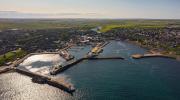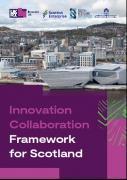First superfast broadband connection for rural Scotland project
18th February 2014
A historic north-east fishing community is the first location in Scotland to become superfast broadband enabled as part of a £410m publicly-funded project.
Deputy First Minister Nicola Sturgeon today (Tuesday 18 February 2014) announced that the first cabinet bringing next generation broadband services to rural Scotland is now live in the Moray town of Buckie.
The announcement signals the start of the most challenging next generation broadband project to be undertaken anywhere in the UK. The new fibre backbone will extend to remote communities across Scotland and will provide a platform for future economic development and regeneration across the region.
Around 400 premises in Buckie can now order fibre services and this figure will increase to more than 5,300 as BT engineers complete the local upgrade in the weeks ahead. Additional locations across Scotland will follow, with broadband infrastructure installed and upgraded across the country. In the Highlands and Islands this will include other parts of Moray and around Inverness which are due to go live by April.
Ms Sturgeon said: "Today marks an important milestone for the Digital Scotland Superfast Broadband partnership and for the people of Buckie who are the first in Scotland to benefit from this service.
"It’s fantastic news that local households and businesses will now see the benefits of high quality digital connectivity.
"The scale of the challenge of delivering fibre broadband into rural Scotland outstrips any other part of the UK.
"This is one of the most ambitious broadband infrastructure projects ever to have been undertaken and will see 95% of premises in Scotland covered by 2017/18.
"This is an important step towards ensuring that Scotland has world-class digital connectivity by 2020. Our investment, and that of our partners in the project, will extend access to superfast broadband across Scotland. This will be a key factor in ensuring Scotland’s long-term economic prosperity."
UK Government Communications Minister Ed Vaizey said: "More than 600,000 Scottish homes and businesses will be able to access superfast broadband as a result of the Government’s program, which will see a remarkable transformation of broadband throughout the country. The UK already does more business online than any other European country and widespread access to superfast speeds will provide a welcome boost to Scotland’s economy."
The Digital Scotland Superfast Broadband project is being delivered in two parts - one covering the Highlands and Islands and the other covering the rest of Scotland. Both projects are being delivered on the ground by BT. Highlands and Islands Enterprise (HIE) is leading on the £146m project for its region.
Alex Paterson, HIE's Chief Executive, commented: "The introduction of high-speed broadband in Buckie marks the start of a rollout process which will ensure the Highlands and Islands fulfils its ambition to be a digital region.
"Creating the fibre network which lies at the heart of this project is a massive engineering feat, and the effects for business and communities will be transformational. As well as the social implications in homes across the region, the project has the potential to impact on everything from how we innovate our businesses, and how we deliver our health services to how we open up new markets and attract investors.
"Without public investment a fibre network on this scale simply would not have happened commercially and we are committed to ensuring as many people as possible benefit across the region."
In delivering the Highlands and Islands project BT will rollout more than 800km of new fibre on land, and another 400km of subsea cables connecting the island communities. Coverage levels in all seven local authority areas within the Highlands and Islands project area will represent a significant step change for fibre broadband.
Brendan Dick, director, BT Scotland, said: "The importance of this rather insignificant looking roadside cabinet cannot be understated. It’s the milestone that marks the first time access to fast fibre broadband has been provided to anyone in Scotland as part of this exciting programme.
"Taking fibre broadband to the Highlands and Islands is the most challenging engineering project BT is tackling in the UK. It’s a massive operation which includes the complexities of laying 20 subsea fibre cables in a six-month weather window kicking off in May so it’s great to see our extensive planning and logistics paying off with a live cabinet here in Buckie.
"The internet is playing an increasingly important part in all our lives - whether it’s small businesses keeping in touch with their customers and suppliers, children doing their homework or playing interactive games online, grandparents staying in touch with their grandchildren, or people working from home. Each of these things is made easier, quicker and better by faster fibre broadband."
During the life of the project, BT, HIE and Scottish Government will also be assessing new and emerging technology options through a £2.5 million Innovation Fund, with a view to extending faster broadband to the most remote places in Scotland.
HIE is also leading the nationwide delivery of the £5m Community Broadband Scotland (CBS) initiative, which forms part of the Scottish Governments national digital strategy. CBS is a £5 million initiative targeted at those communities that are least likely to benefit from a next generation broadband solution under the Step Change Programme. The programme provides advice, guidance and project funding to help communities deliver improved digital connectivity.
The rest of Scotland project is being led by the Scottish Government, working together with local authorities and Broadband Delivery UK in the Department for Culture, Media and Sport. This is being supported through £157.6million public funding including £50 million from BDUK and BT investment of £106.7million. The public funding for the rest of Scotland project includes around £51 million which has been invested by fourteen local authorities to increase coverage, meet local priorities and address the digital divide in their areas.
Wick and Thurso exchanges are scheduled to be upgraded to Fibre-to-the-Cabinet in 2015.
Related Businesses
Related Articles
Workforce North event spotlights Highland economy
EMPLOYERS and educators from across the Highlands have gathered to hear how a new initiative is aiming to transform the region's economy. Workforce North - A Call to Action brought together business leaders and teachers from primary and secondary schools from across the Highland Council area with a wide range of partners geared towards education, learning and skills development at Strathpeffer Pavillion.
Tartan challenge for UHI students offers £1,500 prize
Students from across the University of the Highlands and Islands (UHI) partnership have been challenged to design a tartan and be in with a chance of winning a £1,500 cash prize. Highlands and Islands Enterprise (HIE) has launched THE COMPETITION to mark 60 years since the regional development agency (then named Highlands and Islands Development Board) was established in November 1965.
The Rural AI Roadshow - How AI can help your rural business thrive
Scotland's enterprise agencies (Scottish Enterprise, Highlands and Islands Enterprise, South of Scotland Enterprise) The Scottish AI Alliance and The Data Lab have joined forces to plan and deliver an inspiring and educational Rural AI Roadshow. There will be three, one day, Rural AI Roadshow conferences taking place across Scotland in January 2026.
Digital and AI innovation round-up for November
Scotland's digital future is accelerating, with AI and tech innovation transforming businesses. In this blog, HIE's Theresa Swayne shares November insights on funding, leadership, and how organisations can harness technology to stay ahead.
Reflections from SEWF Rural: global lessons for the Highlands and Islands social impact economy
As we mark 60 years since the region's economic and community development agency was established, it's timely to reflect on the global aspects of our work on shaping rural futures. The recent Social Enterprise World Forum (SEWF) Rural Gathering in Sabah, Malaysia, welcomed changemakers from Australia, Ireland, India, Canada.
Scottish Entrepreneurial Ecosystem Guide - FREE To Download
Scottish Enterprise's Entrepreneurial Ecosystem Guide provides an overview of more than 150 organisations that support new and growing companies in Scotland. The guide includes incubators, accelerators, specialist industry programmes, co-working spaces and networking organisations.
Funding approved for Wick Harbour port consultant
A specialist ports consultant has been appointed to develop a long-term strategic plan for Wick Harbour Authority (WHA) in Caithness. WHA has secured £47,775 from Highlands and Islands Enterprise (HIE) and the Nuclear Restoration Services, NRS Dounreay towards the cost of the services.
Enterprise and innovation agencies join forces in new framework
Scotland's three enterprise agencies have joined the UK's national innovation agency to agree a collaboration framework that aims to help Scotland become one of the most innovative small nations in the world. The Innovation Collaboration Framework for Scotland brings together Highlands and Islands Enterprise, Scottish Enterprise, South of Scotland Enterprise and Innovate UK with a commitment to support ambitious businesses to invest in research to drive economic growth, create good jobs and help tackle major societal and environmental challenges.
£3.4m HIE investment in Arnish Road, Stornoway
The project, led by the Stornoway Port Authority, will involve upgrading the full length of the 3.3km Arnish Moor Road. Highlands and Islands Enterprise (HIE) has approved a £3.4m contribution to a £7.2m public funding package for a major project to transform road access to strategic industrial and port sites on the Isle of Lewis.
As HIE reaches 60, new chair says best is yet to come
The newly appointed chair of Highlands and Islands Enterprise (HIE) says the region is on the threshold of a new era of economic growth. Angus Campbell's term as chair began officially on 1 November - 60 years to the day since HIE's forerunner, the Highlands and Islands Development Board (HIDB) opened for business with just six employees.
